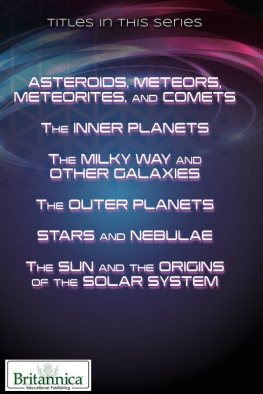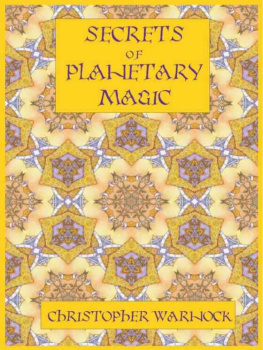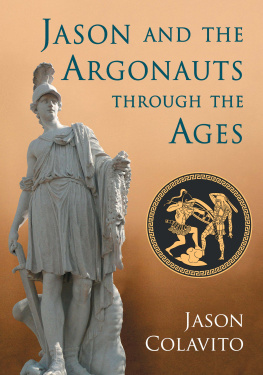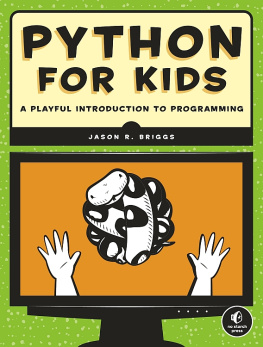Jason J Nishiyama - An Introduction to Planetary Nebulae
Here you can read online Jason J Nishiyama - An Introduction to Planetary Nebulae full text of the book (entire story) in english for free. Download pdf and epub, get meaning, cover and reviews about this ebook. year: 2018, publisher: Morgan & Claypool Publishers, genre: Children. Description of the work, (preface) as well as reviews are available. Best literature library LitArk.com created for fans of good reading and offers a wide selection of genres:
Romance novel
Science fiction
Adventure
Detective
Science
History
Home and family
Prose
Art
Politics
Computer
Non-fiction
Religion
Business
Children
Humor
Choose a favorite category and find really read worthwhile books. Enjoy immersion in the world of imagination, feel the emotions of the characters or learn something new for yourself, make an fascinating discovery.
- Book:An Introduction to Planetary Nebulae
- Author:
- Publisher:Morgan & Claypool Publishers
- Genre:
- Year:2018
- Rating:5 / 5
- Favourites:Add to favourites
- Your mark:
- 100
- 1
- 2
- 3
- 4
- 5
An Introduction to Planetary Nebulae: summary, description and annotation
We offer to read an annotation, description, summary or preface (depends on what the author of the book "An Introduction to Planetary Nebulae" wrote himself). If you haven't found the necessary information about the book — write in the comments, we will try to find it.
An Introduction to Planetary Nebulae — read online for free the complete book (whole text) full work
Below is the text of the book, divided by pages. System saving the place of the last page read, allows you to conveniently read the book "An Introduction to Planetary Nebulae" online for free, without having to search again every time where you left off. Put a bookmark, and you can go to the page where you finished reading at any time.
Font size:
Interval:
Bookmark:

Nebulae
Jason J Nishiyama
Morgan & Claypool Publishers
Copyright 2018 Morgan & Claypool Publishers
All rights reserved. No part of this publication may be reproduced, stored in a retrieval system or transmitted in any form or by any means, electronic, mechanical, photocopying, recording or otherwise, without the prior permission of the publisher, or as expressly permitted by law or under terms agreed with the appropriate rights organization. Multiple copying is permitted in accordance with the terms of licences issued by the Copyright Licensing Agency, the Copyright Clearance Centre and other reproduction rights organisations.
Rights & Permissions
To obtain permission to re-use copyrighted material from Morgan & Claypool Publishers, please contact .
ISBN 978-1-6817-4960-0 (ebook)
ISBN 978-1-6817-4957-0 (print)
ISBN 978-1-6817-4958-7 (mobi)
DOI 10.1088/978-1-6817-4960-0
Version: 20180501
IOP Concise Physics
ISSN 2053-2571 (online)
ISSN 2054-7307 (print)
A Morgan & Claypool publication as part of IOP Concise Physics
Published by Morgan & Claypool Publishers, 1210 Fifth Avenue, Suite 250, San Rafael, CA, 94901, USA
IOP Publishing, Temple Circus, Temple Way, Bristol BS1 6HG, UK
This book is dedicated to my wife Chantelle and my son Simon
for their understanding while I was writing.
To those who look at the stars and wonder.
Our lives here on our small world are intimately tied to the lives of the stars. The matter that we are made of was mostly made either in the cores of stars or in the explosion of stars. In both cases we owe our existence to the deaths of a untold numbers of stars billions of years in the past. Our own star, the Sun, will also succumb to the march of time. Having spent its nuclear fuel it will also send the elements it made during its lifetime into the Galaxy. It is possible that in the Suns death throes it will become a planetary nebula.
Planetary nebulae mark the deaths of low and intermediate mass stars. Though not as instantaneously spectacular as the supernova deaths of high mass stars, planetary nebulae have a beauty all their own. Though we have observed them for a few hundred years, it is only in the past few decades that we have figured out what they are and their place in the lives of stars. Even now there are many aspects of planetary nebulae that elude our understanding making these objects the subject of active research.
In this book we will look at what planetary nebulae are, where they come from and where they go. We will discuss what mechanisms cause these beautiful markers of stellar demise as well as what causes them to form their variety of shapes. How we measure various aspects of planetary nebulae such as what they are made of will also be explored. Though we will give some aspects of planetary nebulae mathematical treatment, the main points should be accessible to people with only a limited background in mathematics. A short glossary of some of the more arcane astronomical terms is at the end of the book to help in understanding. Included at the end of each chapter is an extensive bibliography to the peer reviewed research on these objects and I would encourage the reader interested in an even deeper understanding to read these articles.
Jason Nishiyama
Calgary, March 2018
The author would like to acknowledge the various professors, instructors, and teachers whose tutelage and mentorship over the years has made this work possible. I would also like to acknowledge the reviewer of this work whose suggestions greatly improved the manuscript. Finally I would like to acknowledge my parents whose purchase of an astronomy sticker book for me as a young child started my lifelong passion for astronomy, physics, and space science.
Jason Nishiyama

Jason Nishiyama is a Sessional Lecturer with the University of Lethbridge Calgary Campus and is the director of the RASC Calgary Centres Wilson Coulee Observatory. He received his MSc in Astronomy from the Swinburne University of Technology in Melbourne, Australia. His current research is in planetary nebulae morphology. Jason lives in Calgary, Canada.
Planetary nebulae are a class of short lived (on the order of 105 years) astronomical objects that represent the penultimate stage of stellar evolution of stars in the range of one to eight solar masses. This places planetary nebulae between asymptotic giant branch stars (AGB) and white dwarfs in terms of stellar evolution. They are comprised of gas and dust that has been ejected off the AGB star. The AGB star that is the precursor to the planetary nebula is known as the progenitor star. This gas is being exited by ultraviolet light from the planetary nebulas central star which is the remnant of the core of the progenitor. AGB. This star is hot enough to produce the ultraviolet light needed to excite the gas envelope that forms the nebula itself. The central stars of planetary nebulae are no longer undergoing fusion reactions and will eventually become white dwarf stars.
That we know this is relatively recent knowledge. Despite the first planetary nebula being discovered in 1764, our understanding of what they are, where they come from, how they form and what they evolve into has only been understood in the past 50 or so years. That we are still learning much about these objects make them an interesting field of study.
Though comparatively bright objects there are no planetary nebulae close enough to the Earth to be visible to the unaided eye. Using a V band filter, a standard filter that has a spectral response closest to the human eye, the brightest planetary nebula has a magnitude on the order of 7.5. This is well below the approximately 6th7th magnitude that is visible to the unaided eye. This prevented the discovery of these objects until the era of the telescope.
The first recorded instance of a planetary nebula being observed is in 1764. French comet hunter Charles Messier noted on July 12 of that year that he had observed Nebula without star, discovered in Vulpecula, between the two forepaws and very near the star 14 of that constellation, of 5th magnitude according to Flamsteed; one can see it well with an ordinary telescope of 35 foot). Messier was unaware of the nature of this object beyond it being a fuzzy cloud in his telescope and so in his notes it was simply listed as a nebula. Messier added a total of four planetary nebulae to his list though he personally only discovered two of them.
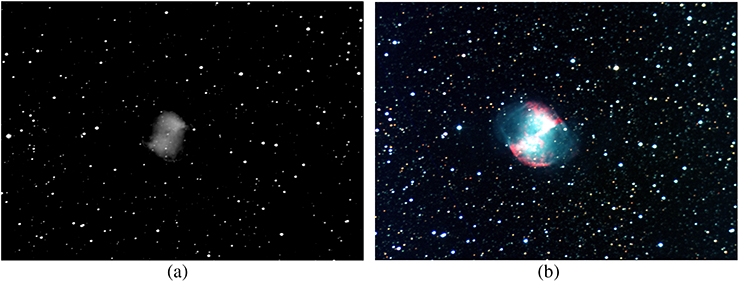
Figure 1.1. The Dumbbell Nebula as (a) Messier would have seen it and (b) a modern image. (Authors images.)
Though the first planetary nebula was discovered in 1764, it would take another 20 years before they were given their rather curious name. Though the name implies an association with planets they are in fact unrelated objects. Their rather confusing name comes from William Herschel who, after receiving a copy of Messiers list in the 1780s, began an intensive observation program to discover and catalog nebulae and star clusters. In a matter of a few years Herschel with his sister Caroline had cataloged upwards of 2500 objects. In order to help categorize what they had found Herschel developed a classification system based on how the objects looked through the telescope []. As he had recently discovered the planet Uranus, and some of the nebulae looked similar, he called these objects planetary nebulae. The name has endured ever since, no doubt causing confusion among non-astronomers. Herschel and his sister would eventually go on to discover about 30 planetary nebulae.
Font size:
Interval:
Bookmark:
Similar books «An Introduction to Planetary Nebulae»
Look at similar books to An Introduction to Planetary Nebulae. We have selected literature similar in name and meaning in the hope of providing readers with more options to find new, interesting, not yet read works.
Discussion, reviews of the book An Introduction to Planetary Nebulae and just readers' own opinions. Leave your comments, write what you think about the work, its meaning or the main characters. Specify what exactly you liked and what you didn't like, and why you think so.



